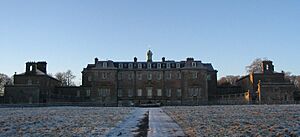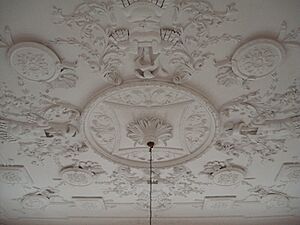Marchmont House facts for kids
Marchmont House is a grand old house located near the village of Greenlaw in Berwickshire, Scotland. It's about five miles (8 km) southwest of Duns and 19 miles (30 km) west of Berwick-upon-Tweed. The house sits in a beautiful area with rolling hills, and the Blackadder Water river flows through the estate. You can see the Lammermuir Hills to the north and the Cheviot Hills to the south. This part of Berwickshire, called the Merse, is known for its lovely scenery and good farmland.
Contents
A Look Back in Time
The main part of Marchmont House was built in 1750. It was created by Hugh Hume-Campbell, the 3rd Earl of Marchmont. Before this grand house was finished, his family lived in a place called Redbraes Castle. You can still see the old ruins of Redbraes Castle near the house today.
One famous person who lived at Redbraes was Sir Patrick Hume of Polwarth, who later became the 1st Earl of Marchmont. He had a very brave daughter named Lady Grisell Hume.
Lady Grisell's Bravery
Sir Patrick Hume got into trouble because he was involved in a secret plan against the king, called the Rye House Plot. To stay safe, he had to hide in the underground rooms of Polwarth Parish Church, which was close to his home. His daughter, Lady Grisell, was a young teenager at the time. She bravely smuggled food to him every day. Her path from Redbraes to the church became known as ‘Lady’s Walk’.
Lady Grisell wrote about her adventures and how scary it was to help her father and family. In 1684, Sir Patrick had to escape to Holland, and Lady Grisell helped him again. But he later returned with King William, who gave back their lands. In 1697, Sir Patrick became the first Earl of Marchmont. He was even given permission to put an orange with a crown on his family's coat of arms, to show the king's thanks.
The House: Inside and Out
The Hume family became very wealthy in the late 1600s. This allowed them to dream of building a magnificent new home. Alexander, the 2nd Earl, started planning the gardens and even asked a famous architect, William Adam, to design the new house. However, Adam's plans were too expensive, and both he and the 2nd Earl passed away before building began.
It was the 3rd Earl who finally built the house. The design is now thought to be by a less famous architect named Thomas Gibson. But William Adam's ideas still influenced the house and its gardens.
Beautiful Interiors
The inside of Marchmont House is considered one of the most beautiful in Scotland. Much of the original plasterwork, made in the 1750s by Thomas Clayton, is still there. Clayton was known as the best plasterer in Scotland at that time.
His best work can be seen in the Saloon, a large reception room. Its ceiling and walls are decorated with military symbols and the family's crests. The Drawing Room has decorations that celebrate nature, with baskets of fruit and flowers. Even the fireplace has carvings that look like the sun's rays.
Later Changes
Over the years, the house has been changed and updated. In the early 1900s, the last Hume family member sold Marchmont House to Robert Finnie McEwen. He hired a famous architect, Sir Robert Lorimer, to make big changes between 1914 and 1917.
Lorimer added a top floor to the house. He also moved the main entrance to the ground floor and added a porch. Inside, the main staircase was removed and a grand new one was built. A huge music room was created in one part of the house. It has beautiful oak wood panels and a large organ that is still played today. This music room shows how much McEwen loved music.
In the 1980s, the house became a nursing home. But recently, it was sold to a private owner who has done a lot of work to restore it. The music room's organ has been fully fixed, and concerts are held there. Some of the old buildings on the estate are now used by skilled furniture makers.
Gardens and Other Buildings
The idea for a grand new house at Marchmont started long before it was built. In 1726, they began planting the Great Avenue, a long driveway lined with trees. They ordered 10,000 elm trees! This avenue is about 1.3 miles (2.1 km) long and is thought to be the longest in Scotland. It still exists today, though many of the trees are now beech trees.
The estate has about 390 acres (1.6 km²) of designed landscape, much like it was originally planned. The gardens were once very formal, with neat patterns. A special ditch called a ha-ha separates the formal gardens from the deer park. This allows you to see the deer park clearly, making the garden seem to stretch endlessly into the wilder landscape. Many old trees grow here, some from the late 1700s. In 1962, the tallest oak tree in Britain was found at Marchmont!
Pet Cemetery
Hidden among the trees behind the house, you can find a special cemetery for pets. It has 23 small headstones, mostly for foxhounds. The stones date from 1866 to 1891 and show the names of the dogs that belonged to Patrick Hume's hunting packs.
Other interesting buildings on the estate include the old farm buildings, a clock from 1746, and a bridge designed by William Adam in 1759. There are also beautiful walled gardens with a large greenhouse built in 1915.
Marchmont's Railway Station
Marchmont House even had its own private railway station! It was part of the Berwickshire Railway line, which opened in 1863. The station closed for passengers in 1951 and for freight in 1965. The old station building is now a private house, but you can still see the platform.
See also





